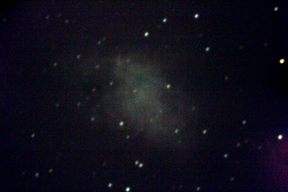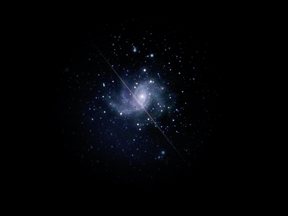Deep Sky objects are technically any object that's not within our Solar System. I've mainly been using the Messier Catalog of 110 deep sky objects as a guide to what to image.
On Saturday, February 11, 2006, I figured out how to hook my camera up to the 3" finder 'scope on top of the 16" Cassegrain at CU Boulder's observatory. That night, despite a 99% full moon, I imaged over a dozen Messier objects. Many of them are on this page from that night.
In the Summer of 2006, CU bought a new - and very good, all things considered - camera for their 8" telescope that's mounted on top of the 18" telescope. Using it, I'm working on photographing many of the smaller Messier objects, and I'll be re-imaging some of the other objects that are presented here (once I have a chance and once they become visible again).
Because I have a significant number of deep-sky objects photographed, I have re-worked this page with JavaScript navigation. You can use the names of the objects below (such as clicking on M15), or you can use the blue arrows to browse between objects.
A note about color: In modern astrophotography, images are taken with digital detectors that are black and white, and each object is imaged through filters that only allow certain colors of light to pass through. Multiple images taken through different filters are then combined and re-colorized to produce the image. This means that you can assign whatever color you want to a real color -- for example, when re-colorizing, you could make the red image green, the green image blue, and the blue image red. When I do color images, I attempt to create as "true" a color image as possible, such that if you were able to look through a telescope and collect light with your eye for 30 minutes, the colors in my images would be the color that you see.
Quick Navigation Links to the Messier Objects
M1, M2, M5, M8, M9, M13, M14, M15, M16, M17
M20, M27, M30, M34, M35, M36, M37, M38
M41, M42, M45, M46, M47, M48, M50, M53, M55, M56, M57
M63, M67, M69, M71, M72, M73, M74, M79
M92, M93
M101
M1 - Supernova Remnant

Click Image for Larger Version
My frirst attempt at imaging the Crab Nebula, the only supernova remnant in the Messier catalogue. It's a pretty bad picture, and I hope to do better next time. This is the first supernova that was observed in "modern" times, and it was observed on June 4, 1054 A.D. It was visible in broad daylight for weeks, and visible at night for months. Chinese astronomers noted it as a "Guest Star."
| Object | Supernova Remnant - M1 |
| Common Name | Crab Nebula |
| Date, Time, & Moon | February 25, 2006; No Moon |
| Location | SBO Telescope at CU Boulder |
| Optics | 18" (45.7 cm) Refractor; ?" (? cm) focal length; f/8 |
| Camera | Canon Digital Rebel 350D XT, ISO 400 |
| Exposure Time | 390 seconds |
| Optical Correction | No Dark- nor Flatframe-Correction |
| Camera Position | Prime Focus |
| Guiding | Passive Clock Drive |
| Processing Details | PhotoShop CS - Aligned color channels separately to remove chromatic aberration; Levels, Curves, and Color Adjustment |
| Image Size | approx. 14 by 99 arcmin |
| Magnitude Depth | Down to at least 12th magnitude. |
| Notes | Shot during my second Mini-Messier Marathon. |
Quick Navigation Links to the Non-Messier NGC Objects
NGC 6946 - Spiral Galaxy

Click Image for Larger Version
NGC 6946 is a spiral galaxy
in the constellation Cepheus. It is one of the best NGC objects, and it
is the first one that I ever imaged. This galaxy was very close to the
roof of the observatory, so the flatfielding didn't work very well, which
is why I isolated the galaxy and deleted everything outside of it. Another
interesting thing is that a satellite flew in front of the galaxy during
imaging, which is the line that goes through from around the 10:30-4:30
position.
This is a relatively nearby spiral galaxy, and it was discovered on September
9, 1798, by William Herschel. This galaxy is relatively close to the plane
of our own galaxy, which makes is relatively hard to image because of obscuring
dust from our galaxy in the way. It's an interesting galaxy in the sense
that (prior to 2005) eight supernova have been detected in it. It is also
known as Caldwell 12, H IV.76, and it is in the SAC 110 best of NGC list
and the RASC's Finest NGC Objects list.
| Object | NGC 6946 - Spiral Galaxy |
| Common Name | -- |
| Date, Time, & Moon | July 23, 2006 @ 2:35-3:10 AM; No Moon |
| Location | SBO Telescope at CU Boulder |
| Optics | 8" (20.3 cm) Cassegrain; 80" (200 cm) focal length; f/10 |
| Camera | ST-2000 |
| Exposure Time | 30 minutes; 6 5-minute images |
| Optical Correction | Dark- and Flatframe-Correction |
| Camera Position | Prime Focus |
| Guiding | Passive Clock Drive |
| Processing Details | CCDOps
- Standard arithmetic reduction. PhotoShop CS - Colorized, adjusted levels, curves, and color. |
| Image Size | Approx. 32.7 by 24.5 arcmin; object size is 11.2 by 9.8 arcmin |
| Magnitude Depth | Object magnitude is 8.8; surface brightness is 13.8 magnitude. |
| Notes | Outside temperature
70 °F; CCD temperature -15 °C. Humidity 45-50%. Airmass during exposure was 1.08-1.10. |